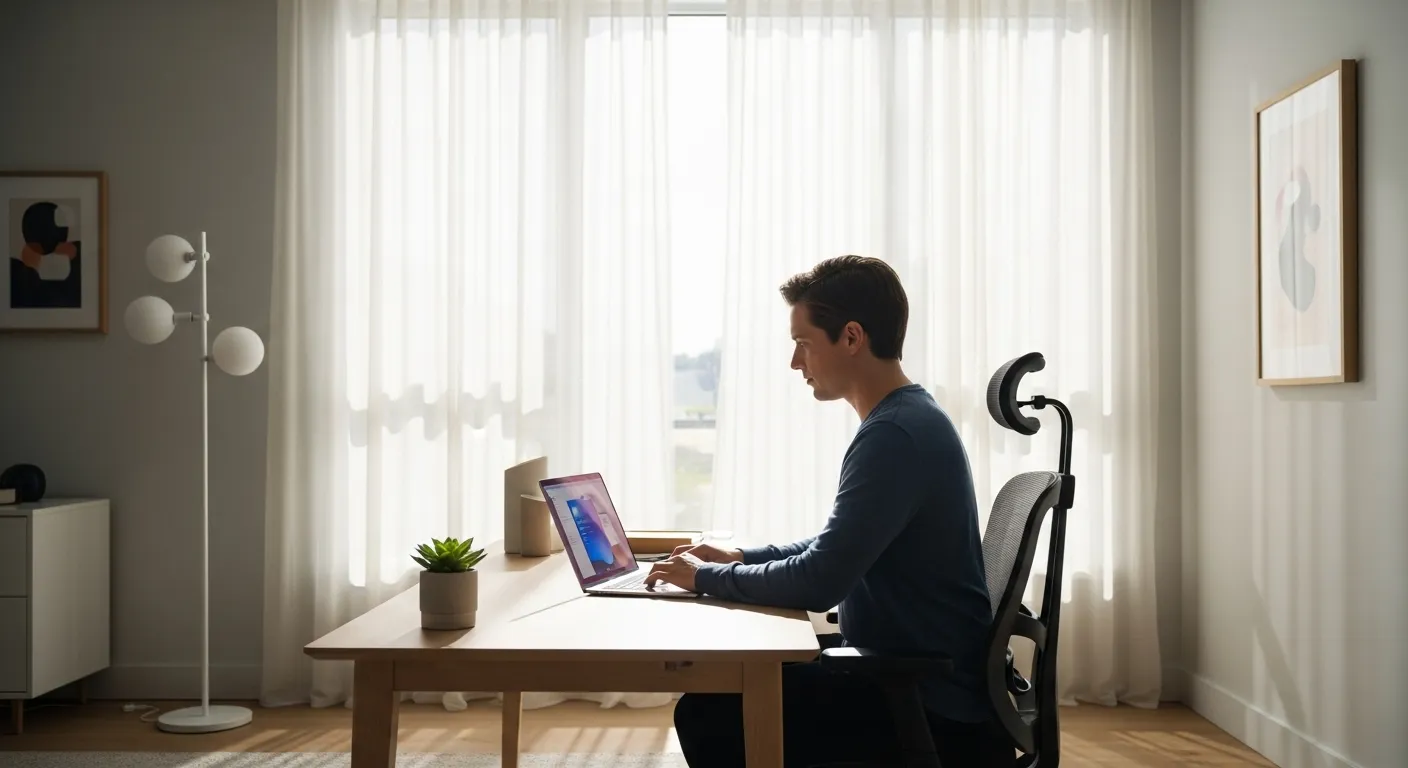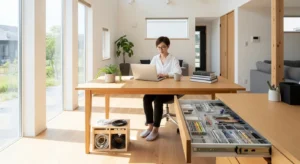
Take a moment and picture your closet. When you open the door in the morning, do you feel a sense of calm and possibility, or a wave of quiet stress? For many of us, the closet is a source of daily friction. It’s the jumble of hangers, the clothes crammed onto the rod, the shoes piled on the floor. This isn’t just a messy space; it’s a series of tiny, frustrating decisions you’re forced to make before you’ve even had your coffee. It represents time wasted, money spent on items you don’t wear, and a constant, low-level drain on your energy.
At The Focused Method, we believe that an organized life isn’t built on marathon cleaning sessions or sheer willpower. It’s built on simple, sustainable systems that work with your natural habits, not against them. A tidy closet isn’t about having a minimalist wardrobe or a custom-built walk-in. It’s about creating an environment where order is the path of least resistance. The goal is a calm, low-maintenance system that makes getting dressed easy and putting things away even easier. You don’t need more discipline; you need a better design for your space and your routines.
This article will guide you through our proven 5-step system to declutter, organize, and maintain a tidy closet. We won’t just tell you to “get rid of stuff.” We’ll show you how to redesign your closet’s flow, reduce decision fatigue, and implement tiny habits that prevent the clutter from ever returning. We’ll define core concepts like the one-touch rule and visual friction to give you the tools to create order not just in your closet, but in any area of your home or work. This is more than just a quick closet organization system; it’s a blueprint for lasting calm.
📚 Table of Contents
- Step 1: The Ruthless Edit – Clearing the Canvas
- Step 2: Zone Your Space – Creating a Blueprint for Calm
- Step 3: Implement the One-Touch Rule – The Secret to Maintenance
- Step 4: Establish Reset Points – Your 10-Minute Tidy
- Step 5: Optimize for Your Reality – Small Spaces and Shared Lives
- Bringing the System to Life: Mini Makeover Examples
- Frequently Asked Questions About Lasting Tidiness
- How do I tackle a huge backlog of paper? It feels too overwhelming to even start.
- What if my partner, family, or roommate isn’t on board with getting organized?
- I really struggle with sentimental items. What should I do with them?
- My closet is tiny. Will this 5-step system even work for me?
- Your First Steps to a Clutter-Free Life
Step 1: The Ruthless Edit – Clearing the Canvas
Before you can organize, you must edit. This is the most crucial step, and it’s about more than just tidying. It’s about consciously deciding what earns the right to take up your valuable physical and mental space. Every item in your closet that you don’t wear, don’t love, or doesn’t fit creates what we call visual friction. This is the distracting, chaotic noise that your brain has to process every time you look at it. A closet overflowing with unworn clothes is a space screaming with visual friction, making it impossible to see the things you actually want to wear.
The first goal of this quick closet organization system is to silence that noise. To do this, you must take everything out. Yes, everything. Don’t just shift things around on the rod. Empty the entire closet onto your bed. This act is powerful because it forces you to physically handle every single item and make an intentional choice about its future. It resets the space to a blank canvas, preventing you from unconsciously keeping things just because they’ve always been there.
As you pick up each piece of clothing, shoe, or accessory, ask yourself a series of honest questions. Does this fit my body right now? Not the body I hope to have or used to have. Does it fit the life I live right now? That beautiful cocktail dress is lovely, but if you haven’t had an occasion to wear it in three years, it’s just taking up prime real estate. Have I worn it in the last 12 months? If not, the odds of you wearing it in the next 12 are slim. And most importantly: does this item make me feel good when I wear it?
Create three distinct piles as you work: Keep, Donate/Sell, and Discard. The Keep pile is for items that get an enthusiastic “yes!” to the questions above. These are your go-to pieces, the ones that fit well and make you feel confident. The Donate/Sell pile is for items in good condition that no longer serve you. They can have a second life with someone else. The Discard pile is for items that are stained, torn, or too worn to be passed on. Be ruthless here. Holding onto things out of guilt—”but I paid so much for it!”—only perpetuates the cycle of clutter. The money is already spent; don’t let the item continue to cost you your peace of mind.
This process of decluttering is the foundation of tidying your closet in 5 steps. By removing the excess, you are not just making space; you are eliminating decisions. When your closet only contains things you love and wear, getting dressed becomes a simple, enjoyable act instead of a frustrating treasure hunt. You are curating a collection that reflects who you are today, and that is an incredibly empowering first step.

Step 2: Zone Your Space – Creating a Blueprint for Calm
Once you’ve completed your edit and are left with only the items you truly want to keep, the next step is to create a logical home for everything. This is where we introduce the concept of working zones. A working zone is a designated area for a specific category of items, grouped together to make finding and storing them intuitive. The goal is to design a system so clear that you could find something in the dark. This is the core of effective closet organization.
Think of your closet like a small city. You have different neighborhoods for different activities. In your closet, this means all your work blouses live together, all your casual t-shirts are in another section, your workout clothes have their own drawer or shelf, and so on. Don’t just group by item type (e.g., all shirts together). Get more granular. Separate short-sleeve shirts from long-sleeve shirts. Group pants by type: jeans, trousers, casual leggings. This hyper-organization drastically reduces the time it takes to find a specific item and assemble an outfit.
Beyond grouping, consider the flow of your space and the frequency of use. The most valuable real estate in your closet is the area between your shoulders and your knees, directly in your line of sight. This prime space should be reserved for the items you wear most often. If you wear jeans and sweaters five days a week, they should be front and center. That one formal suit or special occasion dress? It can be stored in a garment bag at the far end of the rod or on a higher shelf. Seasonal items, like heavy winter coats or summer sundresses, should be moved to less accessible zones during their off-season. You might store them in vacuum-sealed bags under the bed or on the top shelf of the closet.
We advocate for a label-light approach. While a label maker can be satisfying, a truly well-designed system shouldn’t need one. The zones themselves should be the labels. When all your sweaters are folded neatly on one shelf, you don’t need a label that says “Sweaters.” The visual consistency of the items becomes its own organizational cue. This makes maintenance effortless because the system is self-explanatory. The goal is to be able to put something away without thinking, and clear working zones make that possible.
Use simple tools to help define these zones. Drawer dividers can turn a jumbled drawer of socks and underwear into a tidy grid. Matching, slim-profile hangers not only save a surprising amount of space but also create a serene, uniform look, further reducing visual friction. By assigning a permanent, logical home to every single item, you are eliminating the guesswork from getting dressed and, more importantly, from putting things away.

Step 3: Implement the One-Touch Rule – The Secret to Maintenance
You’ve edited your wardrobe and zoned your closet. Now comes the secret to keeping it that way forever: the one-touch rule. This is perhaps the most powerful habit you can adopt for a consistently tidy life. The concept is simple: from the moment an item enters your hand, you should aim to handle it only once on its way to its final home. No stopping on a chair, no dropping it on the dresser “for later,” no putting it in a temporary holding pile. You touch it, and you put it away. Period.
Think about the common clutter points in a bedroom. The most frequent culprit is “the chair”—that piece of furniture that becomes a secondary closet for clothes that are not quite dirty but not quite clean. The one-touch rule eliminates the chairdrobe. When you take off your work clothes at the end of the day, you make an immediate decision. Are they dirty? They go directly into the laundry hamper (one touch). Can they be worn again? They go directly back on their hanger or folded onto their shelf in the closet (one touch). There is no third option.
This rule is a powerful antidote to procrastination. Putting one shirt on a hanger takes about ten seconds. Dealing with a mountain of clothes that has accumulated on a chair for a week takes twenty minutes and a significant amount of mental energy. The one-touch rule saves you that future pain by investing a few seconds in the present moment. It transforms the act of putting things away from a chore into a simple, non-negotiable reflex.
This principle extends far beyond your closet. When the mail comes in, you stand over the recycling bin and apply the one-touch rule. Junk mail is immediately discarded (one touch). Bills are opened and placed in your “Action” file or inbox (one touch). Magazines are placed in the reading basket (one touch). There is no “mail pile” on the kitchen counter. When you bring groceries home, you don’t leave the bags on the floor to unpack later. You take items out and put them directly into the pantry or refrigerator (one touch).
Adopting the one-touch rule is about building an environment that supports immediate action. It’s about closing the loop. An open loop—a task started but not finished, like a shirt left on the bed—is a tiny drain on your cognitive resources. Your brain knows it’s an unfinished task, and it adds to your overall mental load. By consistently applying the one-touch rule, you close hundreds of these tiny loops every week, freeing up mental space and creating a profound sense of calm and control. This single habit is the engine that will keep your newly tidy closet looking perfect day after day.

Step 4: Establish Reset Points – Your 10-Minute Tidy
Even with the best systems in place, life happens. On a rushed morning, you might try on three shirts before deciding on one. A busy week might leave a small pile of things slightly out of place. This is normal. The key to preventing this minor disarray from escalating into full-blown clutter is to establish reset points. A reset point is a short, scheduled, and non-negotiable block of time dedicated to returning a space to its baseline state of order.
For your closet, this could be a 10-minute “closing shift” at the end of each day. Before you wind down for the night, you take ten minutes to reset your bedroom and closet. This involves hanging up the clothes you wore that day (or putting them in the hamper), putting your shoes back on the rack, placing your jewelry or watch in its designated spot, and clearing any surfaces. It’s not a deep clean; it’s a quick, systematic tidying that ensures you wake up to a calm and orderly space every single morning. This small ritual prevents the slow creep of clutter and reinforces the systems you’ve put in place.
The power of the reset point lies in its consistency and its brevity. Because it’s short, it never feels overwhelming. You can do anything for ten minutes. By making it a regular part of your routine—like brushing your teeth—it becomes an automatic habit rather than a dreaded chore. This daily practice is a cornerstone of any successful closet organization plan. It ensures your hard work from the initial declutter and zoning process is maintained with minimal effort.
You can apply the concept of reset points to other areas of your life as well. Consider a 5-minute desk reset at the end of your workday. You clear away coffee mugs, file stray papers into your inbox, and wipe down the surface. This simple act closes the door on the workday and allows you to start fresh the next morning without facing yesterday’s mess. Similarly, a 10-minute kitchen reset after dinner—loading the dishwasher, wiping counters, sweeping the floor—ensures the heart of your home is always ready for the day ahead.
Think about where you need reset points most in your life. Identify the one or two areas that cause the most friction and schedule a brief, daily reset. Set a timer and put on some music. Make it a pleasant, mindful ritual. These small, consistent investments of time pay massive dividends in long-term order and peace of mind. They are the maintenance plan that guarantees your tidy systems will last.

Step 5: Optimize for Your Reality – Small Spaces and Shared Lives
A perfect system on paper is useless if it doesn’t work for your actual life. The final step in creating an instantly tidy closet is to adapt these principles to your specific constraints, whether that’s a tiny apartment, a shared space with a partner, or a limited budget. Organization is not one-size-fits-all; it’s about creative problem-solving.
For those living in small apartments or homes with limited closet space, the key is to think vertically and creatively. Maximize every inch of your closet. Use slim velvet hangers to fit more clothes on the rod without them slipping. Install a second tension rod to double your hanging space for shirts and pants. The back of the closet door is a goldmine of unused real estate; an over-the-door shoe organizer can hold not just shoes, but also scarves, belts, or cleaning supplies. Under-bed storage containers are perfect for stashing off-season clothing, extra linens, or sentimental items, keeping your primary closet space reserved for daily-use items. The goal is to get things off the floor and use the full volume of your space.
When you share a space with a partner, spouse, or roommate, communication and clearly defined boundaries are paramount. The principles of zoning become even more critical. Visually divide the closet space. This might mean one person gets the left side and the other gets the right, or one gets the top rod and the other gets the bottom. The important thing is that each person has their own designated zones. This minimizes conflict and makes it clear who is responsible for which area. A shared “inbox” system for mail and household papers can also be a lifesaver, ensuring that important documents are handled collaboratively rather than accumulating in random piles.
Finally, achieving a tidy closet does not require a large budget. You don’t need a custom closet system from a high-end store. Many of the most effective organizational tools are inexpensive or even free. Sturdy shoe boxes can be used to corral small items on shelves. Drawer dividers can be purchased for a few dollars. Repurposed jars and containers from your kitchen can organize jewelry or accessories. You can find affordable and clever storage solutions at places like IKEA or by browsing the selections at stores like The Container Store for inspiration. The focus should be on function, not on having a picture-perfect, professionally designed space. A well-organized closet is one that works for you, supports your daily routine, and brings you a sense of calm, regardless of how much it cost to create.

Bringing the System to Life: Mini Makeover Examples
To see how these principles work in practice, let’s walk through two common household clutter zones and apply the 5-step system in prose. These aren’t just about tidying; they are about redesigning the flow of everyday life.
Mini Makeover 1: The Home Office Desk
Imagine a home office desk buried under piles of paper. There are old project notes, incoming mail, bills to pay, and a stack of articles to read. It’s a landscape of visual friction and a major source of stress. First, we apply Step 1: The Edit. We take every single piece of paper off the desk. We create three piles: Action (bills to pay, forms to sign), File/Reference (documents to keep), and Recycle. Anything older than a few months that hasn’t been referenced is immediately recycled. This ruthless edit clears the canvas.
Next is Step 2: Zoning. The desk surface is now for active work only—a laptop and a notepad. We create clear zones for paper. A simple, three-tiered vertical file holder becomes the new command center. The top tier is the “Inbox” for all new, unprocessed paper. The middle is “To Pay/Action,” and the bottom is “To File.” This creates a clear, logical blueprint. For Step 3, the One-Touch Rule, all new mail is opened over the recycling bin. Junk is tossed. Actionable items go directly into the Inbox. The rule is: no paper lives on the desk surface itself. Its home is in the tiered file holder until it is processed. To maintain this, we establish Step 4: A Reset Point. At the end of each workday, a 5-minute reset is performed. The Inbox is quickly sorted, any used mugs are taken to the kitchen, and the desk surface is wiped clean. Finally, for Step 5: Optimize for Reality, we recognize that digital clutter is also a problem. A corresponding “To Scan” folder is created on the desktop, and a weekly task is set to digitize and then shred documents from the “To File” tray, adapting the system for a modern, paper-light workflow.
Mini Makeover 2: The Kitchen Command Center
Now, picture the classic cluttered kitchen counter. It’s a dumping ground for keys, wallets, sunglasses, school permission slips, and takeout menus. It’s a bottleneck that slows everyone down. We begin with Step 1: The Edit. Everything is cleared from the counter. Old menus are tossed, expired coupons are recycled, and mystery items are discarded. We are left with only the essentials that need a home in this high-traffic area.
For Step 2: Zoning, we create a dedicated Command Center on a small section of wall space near the door. We install a few simple tools: a magnetic key rack, a small wall-mounted file holder with two slots (“Incoming” and “Action Required”), and a small corkboard for urgent reminders like permission slips. This creates a designated working zone for the family’s administrative life. Then comes Step 3: The One-Touch Rule. The family builds the new habit: when you walk in the door, keys go on the hook, mail goes in the “Incoming” slot, and permission slips are pinned to the board. Nothing is ever just dropped on the counter. To ensure it lasts, we create Step 4: A Reset Point. Every evening before bed, one person is responsible for the 3-minute “Command Center Reset.” They sort the “Incoming” slot, deal with anything in the “Action” slot, and clear the board of outdated notes. Lastly, we Step 5: Optimize for Reality. A shared digital family calendar is linked via a QR code on the corkboard. This acknowledges that the family operates both physically and digitally, and the system bridges that gap, making the Command Center truly functional for a modern, busy family.

Frequently Asked Questions About Lasting Tidiness
How do I tackle a huge backlog of paper? It feels too overwhelming to even start.
The key to tackling any overwhelming project is to break it down into manageable chunks. Don’t try to sort years of paper in one weekend. Instead, set a timer for just 15-20 minutes a day. Grab one box or one pile and work through it. Apply the Edit step ruthlessly: ask if you truly need to keep a physical copy or if a digital scan would suffice. For incoming paper, immediately implement the one-touch rule to prevent the backlog from growing. Progress, not perfection, is the goal. A little bit every day will clear the mountain faster than you think.
What if my partner, family, or roommate isn’t on board with getting organized?
You can’t control other people’s habits, but you can control your own space and lead by example. Start with your own closet, your side of the bedroom, or your own desk. Create systems that are so easy and intuitive to use that others may naturally start to adopt them. When you create a designated, clearly-marked “home” for shared items like keys or mail, you make it easier for others to put things away correctly. Focus on shared zones first and communicate the benefits calmly—”I thought this key hook would make it easier for all of us to find our keys in the morning.” Often, when people experience the benefits of an organized space, they become more willing to participate.
I really struggle with sentimental items. What should I do with them?
Decluttering is not about getting rid of things you love. It’s about making space for them to be honored properly instead of being buried in a cluttered closet. For sentimental items, the goal is curation, not elimination. Instead of keeping every piece of your children’s artwork, choose a few representative pieces to frame or store in a dedicated portfolio. Digitize old photos and letters to preserve the memory without the physical bulk. Create one single, beautiful “memory box” for your most cherished three-dimensional items. By containing your sentimental items in a defined space, you give them importance while freeing up your daily living areas.
My closet is tiny. Will this 5-step system even work for me?
Absolutely. In fact, this system is more critical for small spaces because there is no margin for error. In a small closet, every single item must justify its existence. The Edit (Step 1) becomes the most important part of the process. You must be ruthless about what you keep. Then, Zoning (Step 2) and optimizing for your reality (Step 5) become about maximizing every vertical inch. Use over-the-door storage, shelf risers, and under-bed containers. A well-organized small closet that contains only items you love and wear feels far more abundant than a large, cluttered closet filled with things you don’t use.

Your First Steps to a Clutter-Free Life
You now have the complete 5-step system for an instantly tidy closet, but more than that, you have a new framework for thinking about organization. It’s not a one-time project; it’s a series of small, intentional habits built around systems that make order the easiest choice. The goal is to move from a state of constant reaction to clutter to a state of calm control over your environment.
True organization is not about perfection. It’s about creating a functional, peaceful space that supports your life instead of draining your energy. By editing what you own, creating logical zones, adopting the one-touch rule, and committing to brief daily resets, you are designing a life with less friction and more focus. This method empowers you to stop relying on willpower and start relying on the power of a well-designed environment.
Don’t wait for the “perfect time” to start. Begin today with one small, achievable action. Here are three simple resets you can do this week to begin your journey:
1. The 10-Minute Surface Reset: Choose one flat surface that is currently cluttered—your nightstand, a kitchen counter, or the top of your dresser. Set a timer for 10 minutes and clear it completely. Put every item in its proper home or in a donation box. Wipe the surface clean. Enjoy the feeling of that one clear space.
2. Designate One Home: Pick one item that frequently gets lost or left out, like your keys, wallet, or glasses. Choose a permanent, logical home for it—a small bowl by the door, a hook on the wall. For the next week, be relentlessly consistent about putting that one item in its home every single time.
3. The One-Hanger Edit: Open your closet right now. Find one item of clothing you know you haven’t worn in over a year. Take it off the hanger and place it directly into a bag for donation. You have just started the editing process. It’s that simple.
By taking these small steps, you are not just tidying a closet; you are building momentum. You are proving to yourself that a calm, organized life is not only possible but sustainable. Welcome to The Focused Method.
Disclaimer: The information provided in this article is for informational purposes only and does not constitute professional, financial, or legal advice. Please consult with a qualified professional for advice tailored to your specific situation.
For expert guidance on productivity and focus, visit Mindful.org, American Psychological Association (APA) and Society for Industrial and Organizational Psychology (SIOP).






